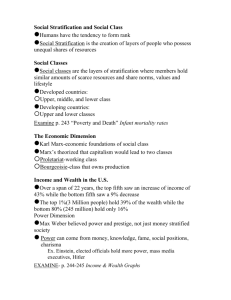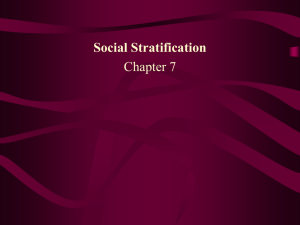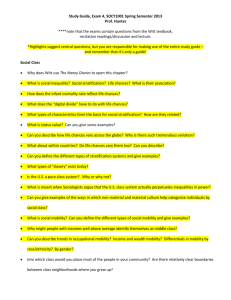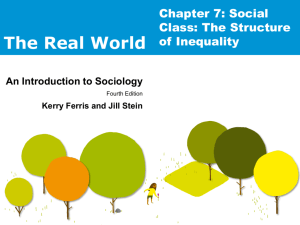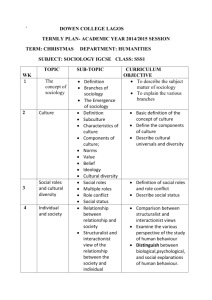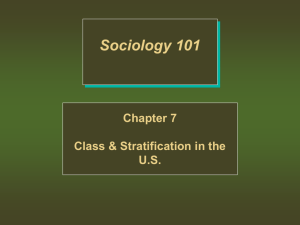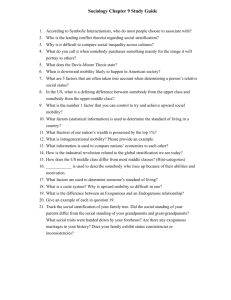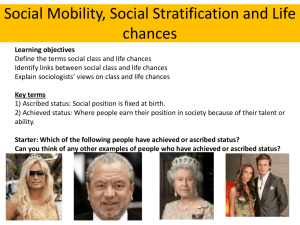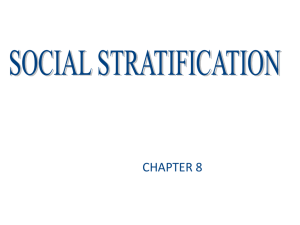Chapter 10, Social Stratification
advertisement
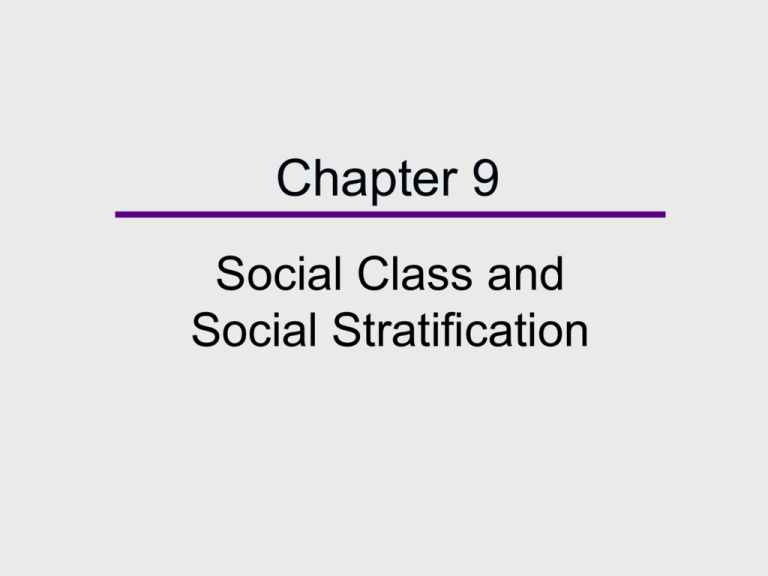
Chapter 9 Social Class and Social Stratification Chapter Outline Social Differentiation and Social Stratification Why Is There Inequality? The Class Structure of the United States Diverse Sources of Stratification Social Mobility Poverty Social Differentiation The process by which different statuses develop in any group, organization, or society. In a sports organization, players, owners, managers, fans, cheerleaders, and sponsors all have a different status within the organization. Social Stratification A relatively fixed, hierarchical arrangement in society by which groups have different access to resources, power, and perceived social worth. In a sports organization: Owners control the resources of the teams. Players earn high salaries, yet do not control the team resources. Sponsors provide the resources. Fans provide revenue. Inequality in the United States Nearly 1 in 6 children in the U.S. live poverty: 30% of African American children 29% of Hispanic children 12% of Asian American children 9.4% of White non-Hispanic children Inequality in the United States 15% of the U.S. population has no health insurance. The average cost of a day’s stay in the hospital is $1, 217—two weeks’ pay for the average worker Inequality in the United States 1% of the U.S. population controls 38% of the total wealth in the nation. The bottom 20% owe more than they own. CEOs of major companies earn an average of $13.1 million dollars per year. Workers earning the minimum wage make $10,712 per year, if they work 40 hours a week for 52 weeks per year and hold only one job. Types of Stratification Systems Estate - Elite owns property and has control over resources. Caste - rigid hierarchy of classes. Class - status is partially achieved, there is some potential for movement between classes. Marx: Class and Capitalism Defined classes in terms of their relationship to the means of production. Capitalist class owns the means of production. Working class sells their labor for wages. Weber: Three Dimensions to Stratification Class - economic dimension Status - social dimension Party - political dimension Functional and Conflict Theories of Stratification Inequality Motivates people to fill Functionalism positions that are needed for the survival of the whole. Results when those with the Conflict Theory most resources exploit others. Functional and Conflict Theories of Stratification Class Structure Functionalism Conflict Theory Differentiation is essential for a cohesive society. Different groups struggle over resources and compete for social advantage. Functional and Conflict Theories of Stratification Life chances Those who work hardest Functionalism and succeed have greater life chances. The most vital jobs in Conflict Theory society are usually the least rewarded. Social Class in the U.S. Upper class Upper-middle class Middle class Lower-middle class Lower class Polling Question If you were asked to use one of the following four names for your parents' social class, which would you say they belong in? A.) Upper class B.) Middle class C.) Working class D.) Lower class The Laddered Model of Stratification Median Income by Race and Household Status Polling Question People who are rich don't care about those who are less rich. A.) Strongly agree B.) Agree somewhat C.) Unsure D.) Disagree somewhat E.) Strongly disagree The Double Diamond Model of Stratification Income Growth by Income Group: Whites Income Growth by Income Group: Blacks Income Growth by Income Group: Hispanics Wealth and Income Wealth is the monetary value of everything one owns, minus debt. It is calculated by adding all financial assets and subtracting all debts. Income is the amount of money brought into a household from various sources during a given period. Distribution of Wealth and Income The wealthiest 1% own 38% of all net worth; the bottom 80% control only 17%. The top 1% also owns almost half of all stock; the bottom 80% own only 4% of total stock holdings. Who’s Got a Piece of the Pie? The Tax Burden: For Whom? Diverse Sources of Stratification Race, class, and gender are overlapping systems of stratification. Class position is manifested differently, depending on race and gender. Example: A Black middle-class man who is stopped by police when driving through a White middle-class neighborhood may feel his racial status is his most outstanding characteristic, but his race, class, and gender always influence his life chances. Poverty Among the Old and Young Class Consciousness The perception that a class structure exists, along with the feeling of shared identification with others in one’s class. There are two dimensions to the definition of class consciousness: the idea that a class structure exists one’s class identification Defining Social Mobility Social mobility is a person’s movement over time from one class to another. Social mobility can be up or down, although the American dream emphasizes upward movement. Mobility can also be either intergenerational, occurring between generations; or intragenerational, occurring within a generation. Social Mobility Mobility is a collective effort that involves kin and sometimes community. Upward Mobility People who are upwardly mobile are often expected to distance themselves from their origins. Downward Mobility As income distribution is becoming more skewed toward the top, many in the middle class are experiencing mobility downward. Poverty in the U.S. Who are the Poor? In 2002, there were 34.6 million poor people in the U.S. The poor: 31% of Native Americans 24% of African Americans 22% of Hispanics 10% of Asians and Pacific Islanders 10% of Whites Who are the Homeless? Battered women Elderly Disabled Mentally Ill (20-25%) Veterans AIDS victims Who are the Homeless? A 2001 survey of 27 cities found that the homeless population is: 50% African American 35% White 12% Hispanic 2% Native American 1% Asian Reasons for Homelessness Unemployment and/or eviction Reductions in federal support for affordable housing Eroding work opportunities Inadequate housing for low-income people Reasons for Homelessness Reductions in public assistance Inadequate health care Domestic violence Addiction Poverty Status by Family Type and Race Explanations of Poverty Culture of poverty - poverty is a way of life that is transferred from generation to generation. Structural causes of poverty - poverty is caused by economic and social transformations taking place in the U.S. Arguments Against “The Culture of Poverty” Fewer than 5% of the poor are chronically poor. 41% of the able-bodied poor work. The pattern of “welfare cycling” is promoted by wages too low to support a family. Quick Quiz 1. Karl Marx defined classes in terms of their relationship to: a. capitalism b. life chances c. the infrastructure of society d. the means of production Answer: d Karl Marx defined classes in terms of their relationship to the means of production. 2. The monetary value of everything one actually owns is defined as one's: a. income b. cumulative income c. wealth d. net worth Answer: c The monetary value of everything one actually owns is defined as one's wealth. 3. Which of the following statements is false regarding social class? a. Class is a structural phenomenon. b. Class can be directly observed. c. Class influences access to societal resources. d. Class influences how one is served by social institutions. Answer: b The statement, class can be directly observed, is false regarding social class. 4. According to the functionalist perspective, differentiation is essential for a cohesive society. a. True b. False Answer: True According to the functionalist perspective, differentiation is essential for a cohesive society.
